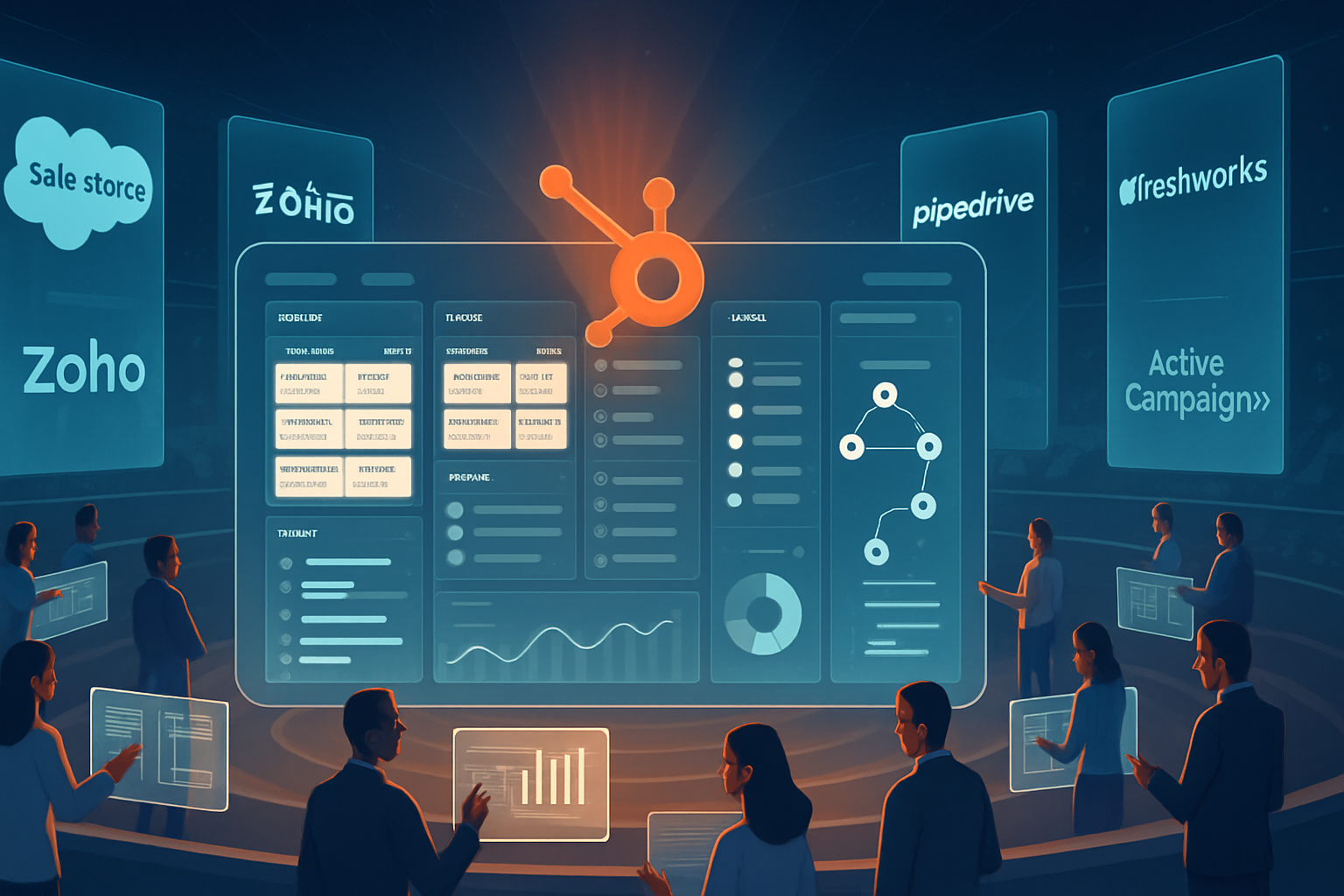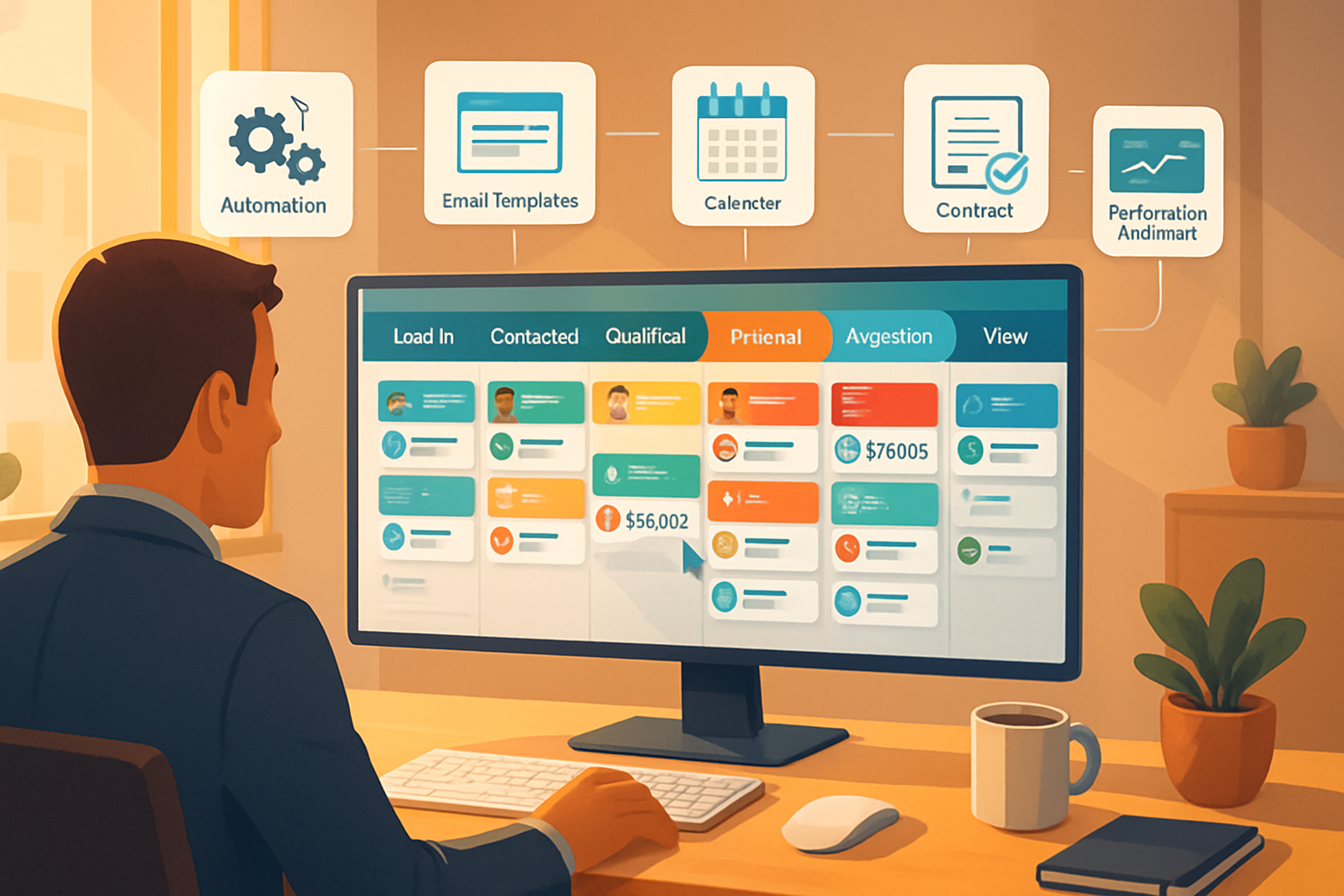· business · 7 min read
The Ultimate Showdown: HubSpot CRM vs. Competitors - Tips for Maximizing Your Investment
A practical, side-by-side guide comparing HubSpot CRM with Salesforce, Zoho, Pipedrive, Microsoft Dynamics and others - plus actionable tips to extract maximum value from each platform and choose the right CRM for your needs.

Outcome first: choose the CRM that fits your people, processes, and growth stage - and then use it so it actually moves your revenue needle.
Why this matters. Pick the wrong CRM or deploy it poorly and you’ll pay in wasted seats, broken workflows, and low adoption. Pick the right one and you get cleaner pipelines, faster deals, and measurably better ROI.
Below you’ll find a clear, practical comparison of HubSpot CRM with its most common competitors, plus platform-specific tips, migration and adoption best practices, cost traps to watch for, and a short decision framework to help you choose.
Quick summary: Who wins at what
- HubSpot - Best for inbound teams who want an all-in-one, low-friction platform that scales from small teams to mid-market. Great UX and marketing-sales alignment.
- Salesforce - Best for large enterprises needing deep customization, complex processes, and a vast partner ecosystem.
- Zoho CRM - Best for budget-conscious teams that need flexible modules and good functionality at a lower price point.
- Pipedrive - Best for pure sales teams who want a pipeline-first, low-complexity tool.
- Microsoft Dynamics 365 - Best for organizations already committed to Microsoft 365 and requiring enterprise-grade integrations.
- Freshsales (Freshworks) - Best for teams wanting built-in phone and a simpler, affordable alternative to the giants.
- ActiveCampaign - Best when advanced email automation and CRM-lite marketing are primary needs.
Now - the details.
Head-to-head feature comparison (practical lens)
HubSpot CRM
- Strengths - Free starter CRM, clean UI, integrated Marketing, Sales and Service Hubs, strong contact/company timeline, native conversations inbox, built-in reporting and attribution.
- Weaknesses - Costs scale quickly for advanced features and large contact lists. Some advanced automation and customization are less flexible than enterprise systems.
- Use tip - Lean into HubSpot’s automated workflows for handoffs (MQL → SQL → Sales outreach). Use property-based lead scoring and behavioral events to prioritize reps’ activities.
- Reference: https://www.hubspot.com/
Salesforce
- Strengths - Highly configurable, massive AppExchange ecosystem, enterprise-grade security and reporting. Best for complex sales processes and integrations.
- Weaknesses - Steeper learning curve, higher implementation costs, often needs a certified admin or consultant.
- Use tip - Limit initial custom objects. Start with standard objects and mature one business process at a time. Budget for at least one admin or consultant for long-term ROI.
- Reference: https://www.salesforce.com/
Zoho CRM
- Strengths - Cost-effective, modular apps (CRM, Desk, Campaigns), decent automation, AI assistant (Zia).
- Weaknesses - UI can be inconsistent across modules; some advanced reporting is less intuitive.
- Use tip - Take advantage of custom modules for industry-specific data but enforce a field governance policy to avoid sprawl.
- Reference: https://www.zoho.com/crm/
Pipedrive
- Strengths - Pipeline-first UX, very simple to use, activity-focused approach, excellent for smaller sales teams.
- Weaknesses - Less depth in marketing automation and service features.
- Use tip - Use Pipedrive’s activity reminders and automation to keep reps consistently logging work - pipeline hygiene is the ROI driver here.
- Reference: https://www.pipedrive.com/
Microsoft Dynamics 365
- Strengths - Deep integration with Office 365, Power Platform (Power BI, Power Automate), strong for enterprises already using Microsoft stack.
- Weaknesses - Complexity and cost; heavy customization requires experienced partners.
- Use tip - Leverage Dataverse and Power Automate for cross-system workflows to reduce bespoke integrations.
- Reference: https://dynamics.microsoft.com/
Freshsales (Freshworks)
- Strengths - Built-in phone and chat, simple UI, good value for SMBs, AI scoring.
- Weaknesses - Fewer third-party integrations than the largest vendors.
- Use tip - Use the built-in calling and contact activity stream to shorten sales cycles; track call outcomes consistently.
- Reference: https://www.freshworks.com/crm/
ActiveCampaign
- Strengths - Exceptional email marketing and automation; great for small-to-medium teams focused on lifecycle marketing.
- Weaknesses - CRM features are present but not as deep as purpose-built CRMs.
- Use tip - Use ActiveCampaign for email-driven customer journeys and integrate with a stronger CRM if you need complex sales management.
- Reference: https://www.activecampaign.com/
Pricing reality check: total cost of ownership (TCO)
List price is rarely the whole story. Include these when budgeting:
- User licenses and contact/contact tier fees (HubSpot counts contacts differently than others).
- Onboarding and implementation (consultants, admins).
- Integrations and middleware (Zapier, Workato, custom dev).
- Add-on modules - sales engagement, enterprise reporting, CPQ, customer success products.
- Ongoing training and change management.
Tip: Build a 24-month TCO model, not a 12-month one. Implementation costs often occur upfront, while recurring savings/benefits roll in later.
Migration & rollout: step-by-step checklist
- Audit current processes and data. Document lead sources, stages, custom fields, and automation.
- Clean before you migrate. Remove duplicates, standardize names and fields, archive stale records.
- Map fields and define defaults. Create a data map - source → destination (include field types and validation rules).
- Test in a sandbox. Run imports with a subset and validate automations, workflows, and reports.
- Train in waves. Start with a pilot team, gather feedback, iterate, then expand.
- Enforce governance. Assign a CRM owner, create naming standards, and set a cadence for data audits.
Migration tip: Export the schema and a sample of records. This reveals hidden fields and integrations you might miss during planning.
Adoption and change management: what actually drives ROI
- Assign an executive sponsor. Nothing replaces visible leadership support.
- Measure usage, not just seats. Track logins, task completions, email sends, and pipeline updates.
- Reward the right behaviors. Tie commission or KPIs to CRM activities that lead to predictable revenue (e.g., logging calls, moving deals on time).
- Keep training short and role-specific. Reps learn by doing; show them how CRM saves time, not how the CRM works.
Behavioral tip: Make a small workflow that automatically creates a task for the rep when a lead hits an SQL stage. Small automation, big habit change.
Platform-specific hacks to squeeze more value
- HubSpot - Use playbooks and Snippets to speed outreach. Use Conversations and a chatbot to reduce support overhead. Configure attribution reporting to show which marketing touches create revenue.
- Salesforce - Use Flow to automate multi-step processes and maintain one canonical source of truth. Invest in AppExchange apps only after evaluating admin overhead.
- Zoho - Use Blueprint to enforce process flows and avoid skipped steps. Leverage Zoho Analytics for cross-app reporting.
- Pipedrive - Automate activity follow-ups and use Smart Docs for fast proposals. Keep pipelines flat and consistent.
- Dynamics - Create Power BI dashboards for executive insights and use Power Automate to reduce manual status updates.
Measuring CRM ROI: the right KPIs
Track these metrics before and after implementation to show impact:
- Conversion rates (lead → MQL → SQL → Opportunity → Win)
- Sales cycle length (time from first contact to closed-won)
- Average deal size and pipeline coverage
- Time saved on manual tasks (hours per rep per week)
- Lead response time
- CRM adoption (active users, tasks completed)
- Customer retention / churn and NPS for service-focused deployments
Quantify improvements where possible. If average deal cycle shortens by two weeks and your average deal is $20k, that’s tangible revenue impact.
Decision framework: which should you pick?
Answer these quickly:
- How complex are your sales processes? (Simple → Pipedrive/HubSpot. Complex → Salesforce/Dynamics)
- How big is your team now and in 24 months? (Small & growing → HubSpot/Zoho. Large enterprise → Salesforce/Dynamics)
- Is marketing automation a priority? (Yes → HubSpot or ActiveCampaign. No → Pipedrive or Freshsales)
- Do you need deep MS Office integration? (Yes → Dynamics)
- What’s your implementation budget? (Low → Zoho/Pipedrive/Freshsales. High → Salesforce/HubSpot enterprise)
Use the answers to find the intersection of product fit and organizational constraints.
Common pitfalls and how to avoid them
- Pitfall - Over-customizing at launch. Solution: Start with configuration, not customization. Iterate after adoption.
- Pitfall - Ignoring data hygiene. Solution: Automate dedupe checks and schedule regular cleanups.
- Pitfall - Choosing only on price. Solution: Model TCO and lost productivity costs from poor fit.
Final, actionable checklist (30–60 day plan)
- Day 0–7 - Stakeholder alignment, success metrics, and CRM owner appointed.
- Day 8–21 - Data audit, field mapping, and a sandbox import test.
- Day 22–35 - Pilot group training, workflows enabled, and first reporting dashboards.
- Day 36–60 - Full rollout, adoption incentives, weekly adoption & data hygiene reporting.
Make this timeline your default playbook. It reduces risk and accelerates time-to-value.
Closing: the strongest point
CRMs are not just software; they are the operating system of modern revenue. The tool matters - but the people, processes, and disciplined adoption matter more. Choose a CRM that fits your current needs and growth path. Then invest in governance, small automations, and measurable goals. Do those three well, and your CRM will stop being an expense and start being a predictable revenue engine.
References
- HubSpot: https://www.hubspot.com/
- Salesforce: https://www.salesforce.com/
- Zoho CRM: https://www.zoho.com/crm/
- Pipedrive: https://www.pipedrive.com/
- Microsoft Dynamics 365: https://dynamics.microsoft.com/
- Freshworks CRM: https://www.freshworks.com/crm/
- ActiveCampaign: https://www.activecampaign.com/



